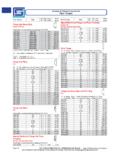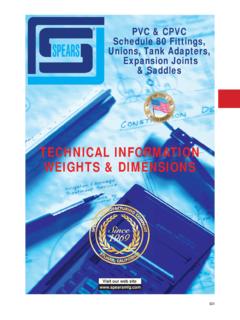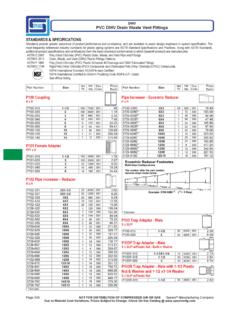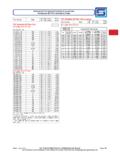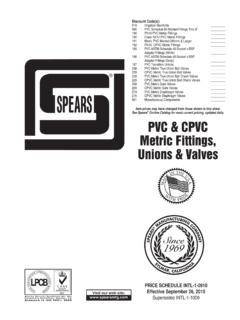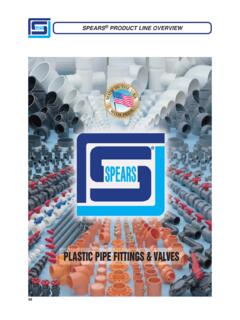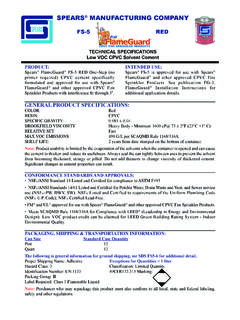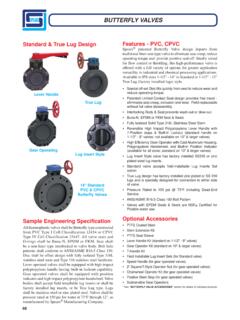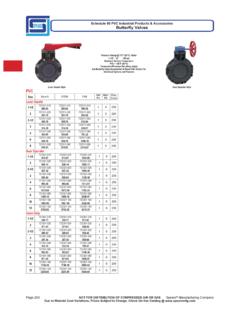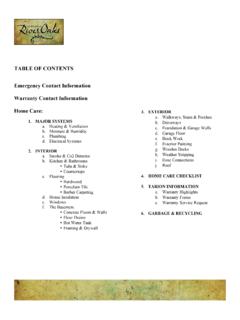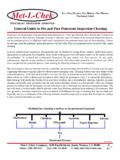Transcription of IP-4-0112 part 1 i-44 Final
1 26 InstallationPlastic piping systems must be engineered, installed, operated and maintained in accordance with accepted standards and procedures. It is absolutely necessary that all design, installation, operation and maintenance personnel be trained in proper handling, installation requirements and precautions for installation and use of plastic pip-ing systems before & StorageSpears products are packaged and shipped with care to avoid dam-age. Pipe and fittings should be stored and protected from direct exposure to sunlight. All pipe and accessories should be stored above ground and fully supported so as not to bend or excessively deflect under its own weight. Proper stacking techniques are neces-sary. Improper stacking can result in instability that may result in pipe damage or personnel care when transporting and storing the product to prevent dam-age. Piping products should not be dropped or have objects dropped on them.
2 Do not drag pipe over articles or across the ground and do not subject pipe to external loads or over stacking. If extended stor-age in direct sunlight is expected, pipe should be covered with an opaque material while permitting adequate air circulation above and around the pipe as required to prevent excessive heat products should not be stored or installed close to heat-pro-ducing sources. PVC storage should not exceed 150 F and CPVC storage should not exceed 210 F. Handling techniques for PVC and CPVC pipe considered acceptable at warm temperatures may be unacceptable at very cold temperatures. When handling pipe in cold weather, consideration must be given to its lower impact strength. In subfreezing temperatures, extra caution in handling must be taken to prevent impact pipe should be inspected for any scratches, splits or gouges before use. Damaged sections must be cut out and Piping ToolsBasic tools used with Plastic PipingUse tools that have been specifically designed for use with ther-moplastic pipe and fittings when installing.
3 A variety of tools that are designed for cutting, beveling, and assembling plastic pipe and fittings, are readily available through local wholesale supply houses dealing in plastic pipe and fittings. 1 Warning Tools normally used with metal piping systems, such as hacksaws, water pump pliers, pipe wrenches, etc., can cause damage to plastic pipe and fittings. Visible and hidden fractures, scoring or gouging of material, and over tightening of plastic threaded connections are some of the common problems resulting from the use of incorrect tools and CuttersPipe must be square-cut to allow for the proper joining of pipe end and the fitting socket bottom. Wheel type pipe cutters designed for plastic pipe provides easy and clean cuts on smaller pipe sizes. Care should be used with similar ratchet-type cutters to avoid damage to pipe. A slightly raised edge left on the outside of the pipe end after cutting with either device must be removed.
4 Pipe Cutters for Large Diameter PipeBlade cutters made for use with large diameter plastic pipe are easy to adjust and operate for square, burr-less cuts. Blades with carbide edges will provide longer life. With one style blade cutter, pipe ends may also be beveled for solvent joints while being cut by using an optional bevel tool in place of one cutter Saws A miter box or similar guide can be used with a fine-toothed saw blades (16 to 18 teeth per inch) having little or no set (maximum inch).Power SawsPower saws are quite useful in operations where a large quantity of pipe is being cut. Blades designed for plastic pipe MUST be used. A cutting speed of 6,000 RPM, using ordinary hand pressure is Beveling ToolsPower beveling tools, as well as hand beveling tools designed for use with plastic pipe are available. Pipe ends must be beveled (chamfered) to allow easy insertion of the pipe into the fitting and to help spread solvent cement and to prevent scraping cement from the inside of the fitting socket.
5 A recommended bevel of 1/16" to 3/32" at a 10 to 15 angle can be achieved using a plastic pipe beveling tool, but can also be accomplished using a file designed for use on ToolsSpecial plastic pipe deburring tools remove burs from pipe ends quickly and efficiently. All burrs must be removed from the inside, as well as the outside, of the pipe ends to properly spread solvent cement when joining pipe and WrenchesStrap wrenches with nylon straps treated for slip resistance and designed for use with plastic pipe provide gripping power for turn-ing without scratching or deforming the VisesChain vises can be used to hold pipe. Vises made with jaws engi-neered for use with plastic pipe provide holding power without damage to the & Joining DevicesPipe and fitting pullers are available for joining large diameter plastic pipe and fittings.
6 These tools are designed to allow the pipe to be inserted to the proper insertion depth, maintain proper alignment dur-ing assembly, and hold freshly solvent-cemented connections to pre-vent the fitting from backing-off until the initial set time is achieved. Joining Methods Solvent Cement WeldingSolvent cement welding is the most widely used joining method for PVC and CPVC pipe and fittings. Other methods such as threads, flanges and groove adapters can also be used. These are specifically useful where it is anticipated that the joint will have to be disassembled in the Cement Safety PrecautionsSolvent cement products are flammable and contain chemi-cal solvents. Appropriate safety precautions must be taken BEFORE APPLYING PRIMER AND CEMENT. Read the cement can label! 1 CAUTIONV irtually all solvent cements and primers for plastic pipe are flam-mable and should not be used or stored near heat, spark or open flames.
7 Do not smoke during use. Eliminate all ignition sources. Primer and PVC cement should be stored in closed containers in the shade at temperatures between 40 F and 110 F; CPVC cement at temperatures between 40 F and 90 F. Use of a can with appli-cator attached to its lid is recommended. Verify expiration dates stamped on cements and primers prior to breathing vapors. They should be used only with adequate ventilation. Explosion-proof general mechanical ventilation is recommended. In confined or partially enclosed areas, a ventilat-ing device should be used. Containers should be kept tightly closed when not in use, and covered as much as possible when in the PipePVC or CPVC pipe can be cut easily with a ratchet cutter, wheel-type plastic pipe cutter (NOTE: be sure to remove any raised ridge produced by wheel cutters), a power saw, or any other fine-tooth saw.
8 It is important that the cutting tools being used are designed for plastic pipe. To ensure that the pipe is cut square, use a miter box when cutting with a saw. Cutting pipe as square as possible provides the maximum bonding surface careful not to split the tube if using a ratchet-type cutter, espe-cially in temperatures below 50 F. If any damage or cracking is evident, cut off at least 2" of the pipe beyond any visible crack. Deburring & BevelingBurrs and filings can prevent contact between the tube and the fit-ting during assembly and must be removed from the outside and the inside of the pipe. A deburring/chamfering tool (or file) is suitable for this purpose:Burrs Being Removed from Outside & InsideA slight bevel (chamfer) must be placed at the outsided end of the pipe to ease the entry of the tube into the socket and minimize the chance of cement being wiped off the fitting:Bevel Outside EndFitting & Joining Preparation1.
9 Using a clean, dry rag, wipe any loose dirt and moisture from the fitting s socket and pipe end. Moisture can slow the cure time, and at this stage of assembly, excessive moisture can reduce joint Check the dry fit of the pipe and fitting. The pipe should enter the fitting s socket easily 1/4 - 3/4 of the way (interference fit) , or at least have interference between pipe and fitting bottom (net fit). DO NOT use any components that appear irregular or do not fit properly. Contact Spears regarding any questions about Measure socket depth and mark on pipe for reference during cement It is advisable to additionally mark pipe and fitting for alignment orientation position, especially with larger contact with skin and eyes. May be absorbed through the skin; wearing PVA coated protective gloves and an impervious apron are recommended. May cause eye injury.
10 Use Eye protec-tion and avoid eye contact. In case of contact flush with plenty of water for 15 minutes. If irritation persists, get medical attention. If swallowed, call a physician immediately and follow precautionary statement given on side panel of cement container. Keep out of reach of to Solvent Cement Material Safety Data Sheet (MSDS) Use Caution with Welding Torches or other equipment where sparks might be involved at construction sites where plastic pipe has recently been solvent welded. Flammable vapors from cemented joints can stay within a piping system for some time. In all cases, lines should be flushed and purged to remove solvent vapors before Caution with Calcium Hypochlorite. Do not use a dry granular calcium hypochlorite as a disinfecting material for water purification in potable water piping systems.
